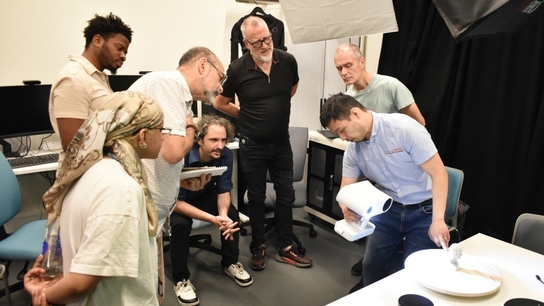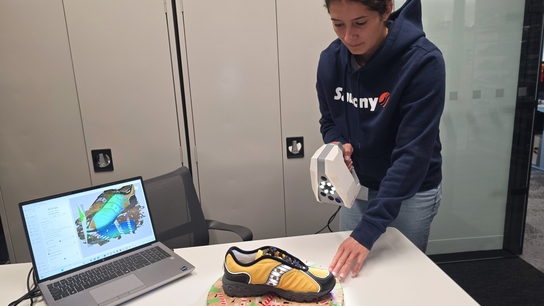3D scanning the largest natural sciences collection in Europe with Artec Eva
The Goal: To create highly-precise, full-color 3D digital models of the entire range of holdings of the museum, using a lightweight, handheld 3D scanner and turntable.
Tools Used: Artec Eva, Artec Studio
The State Darwin Museum is the largest natural sciences museum in Europe and serves to illustrate Charles Darwin's theory on the origin of species. On display are thousands of exhibit items, each with its own entire history behind it. The museum holds nearly 100,000 items in total, 5000 of which can be seen in the main exhibition, while the rest can be found in the museum’s special collections and are used in temporary and traveling exhibitions.
In 2017, the Museum's Department of Multimedia Technologies began its 3D digitization of its collection, using Artec Eva. The resulting scans can now be seen in the museum's profile on sketchfab.com, where 100 models are available for viewing. In addition, the scans are used for preparing 3D content for multimedia and interactive installations, as well as in video clips on the museum's YouTube channel.
Amir Akhtamzyan, the museum's Senior Research Fellow, shares his impressions: “We use the Artec Eva for scanning, which captures with an accuracy of 0.1 mm. To us this scanner offers a universal solution for scanning mid- and large-sized exhibition items and museum artifacts. Another convenient feature is the ability to capture texture in addition to the geometry. The structured lighting built into the scanner allows for textures to be evenly captured, which can later require minor adjustments in color and brightness. The scanner uses contactless technology, so you can place even the most fragile and dilapidated objects on a turn table and commence with scanning. This provides for minimal mechanical contact with the object and makes for an eco-friendly way of digitizing it.”
A skull of a cave bear scanned with Artec Eva
Scanning the Museum's collection began with osteology specimens. Osteology is the study of bones. Up to now 14 of the museum’s animal skulls have been digitized, and among them are rare finds like a Megaladapis skull, an extinct giant lemur, and the skull of a cave bear, which lived in the late Pleistocene and became extinct around 15,000 years ago.
In addition, specimens from the museum's ornithology collection were scanned, resulting in around 80 models of varying types of birds – pelicans, pheasants, ostriches, penguins, and owls. Among them is a unique specimen, a taxidermied great auk, which went into extinction in 1844. There remain 74 preserved great auks in the world, one of which can be found in the State Darwin Museum.
Scan of a taxidermied great auk made with Artec Eva
The museum's holdings recently acquired unusual taxidermied specimens of certain short-haired animals, such as the aardvark, which inhabits Africa. Its outward appearance is akin to that of several animals: its body is similar to that of a kangaroo, especially its tail, its tapered snout - a wild boar’s, its long ears - a hare's. And the pangolin with its “chains” of horned plates over its entire body. But despite its intimidating appearance, it feeds on insects, ants and termites.
Taxidermied aardvark, a short-haired animal that inhabits Africa
The museum's staff have also scanned the busts and sculptures of Neanderthals made by the scientist, Mikhail Gerasimov, who developed the world-renown method of forensic facial reconstruction based on bone remains, which is used in history of science and forensics. Five of Gerasimov's sculptures were scanned - reconstructions of Neanderthals from their earliest sites: the grotto of Skhul, the grottoes of La Ferrassie, Steinheim, and the site of Gibraltar-1. After the busts were scanned, they were resurfaced, skin texture and wrinkles were drawn on, mouth and eye cavities were sculpted, and SSS shader was configured to simulate real skin. Later on facial expressions were added with the help of blendshape and sculpting, thus imparting an animated look to the Neanderthals. The result is the following reconstruction:
The final scan of Neanderthals’ reconstructed model
The Department of Multimedia Technologies of the State Darwin Museum is digitizing its collection using 3D scanner Artec Eva. The 3D models created are to be used in the development of interactive, educational presentations in exhibitions.
The State Darwin Museum is also starting to print museum pieces on a gypsum polymer 3D printer. Here using a 3D scanning device opens up new possibilities for exchanging 3D digital copies and using them in printed form in exhibitions. At the State Darwin Museum, an entire display can be seen, containing scanned objects in printed form.
The museum has plans to further digitize its artifacts, integrate 3D models into social networks (e.g. Facebook), as well as use scans in multimedia files and in the museum’s interactive installations. Using 3D content gives viewers the chance to immerse themselves in the virtual world of digitized space and objects and enables for a more interactive and interesting format for visitors to learn and acquire scientific knowledge.
The scan of a Neanderthal from the grotto of La Ferrassie made with Artec Eva
A woman from the grotto of Steinheim’s scan model
Thanks to the use of 3D scanners, the museum today can be seen in a completely new way, as a storehouse of unique, authentic “models,” which can be used in interactive installations, games, learning applications, and databases for 3D printing.
Artec 3D thanks Amir Akhtamzyan, Senior Research Fellow at the State Darwin Museum, and Dmitry Olshansky, Head of the Department of Multimedia, for the material they provided for this case study.
Scanners behind the story
Try out the world's leading handheld 3D scanners.





